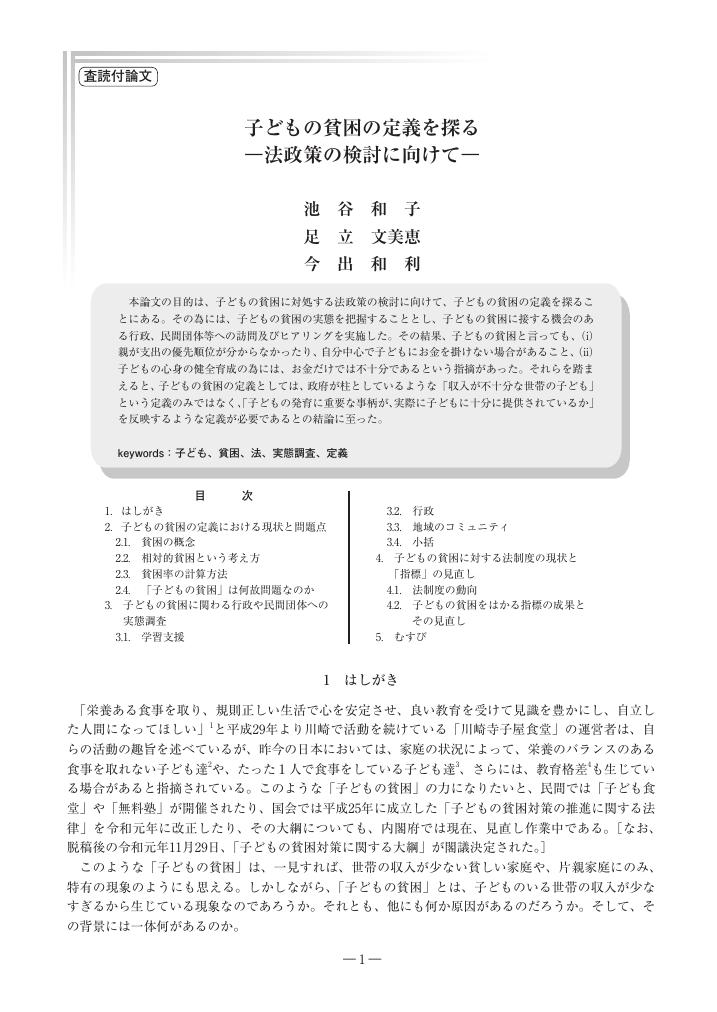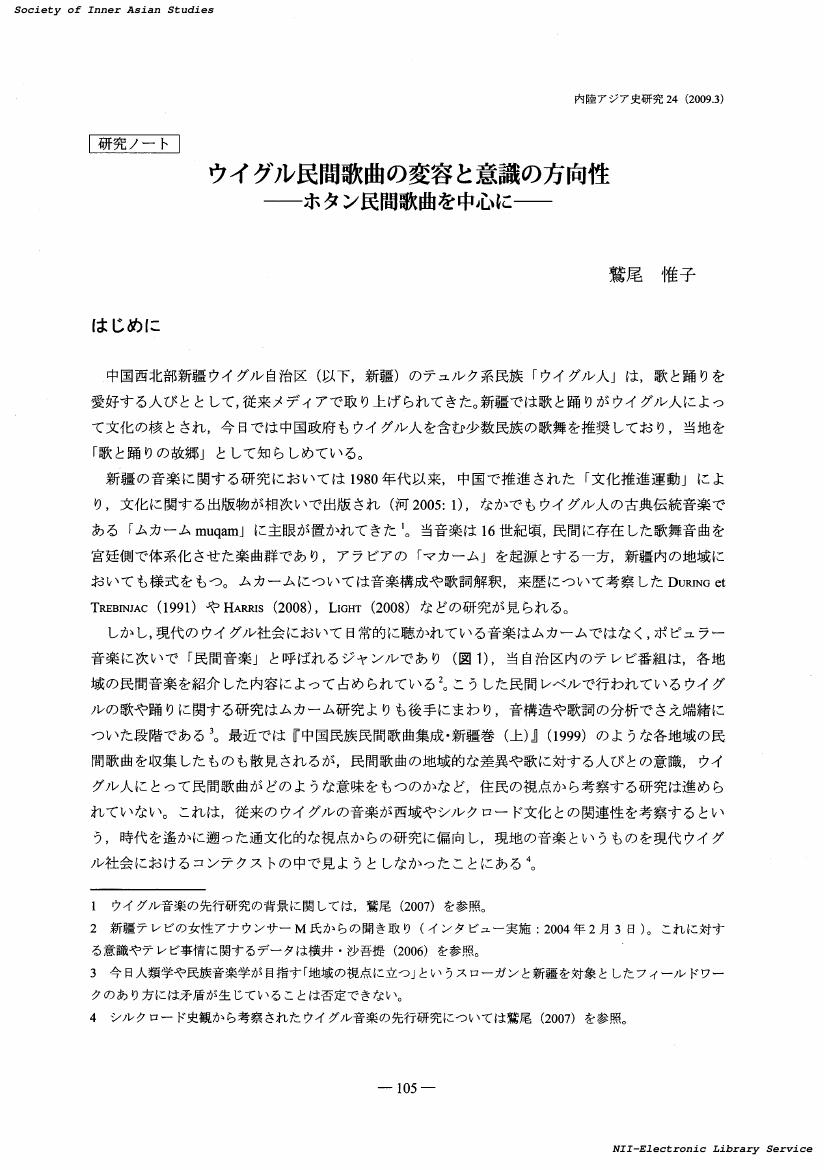- 著者
- 辻 智佐子
- 出版者
- 学校法人 東洋大学現代社会総合研究所
- 雑誌
- 現代社会研究 (ISSN:1348740X)
- 巻号頁・発行日
- vol.2019, no.17, pp.35-52, 2019 (Released:2020-04-24)
2 0 0 0 OA 浜名湖におけるマリンスポーツの潜在ニーズに関する実証分析
- 著者
- 村瀬 慶紀
- 出版者
- 学校法人 東洋大学現代社会総合研究所
- 雑誌
- 現代社会研究 (ISSN:1348740X)
- 巻号頁・発行日
- vol.2019, no.17, pp.25-34, 2019 (Released:2020-04-24)
2 0 0 0 OA 東南アジア家族法における法秩序-インドネシアを素材として-
- 著者
- 佐々木 彩
- 出版者
- 学校法人 東洋大学現代社会総合研究所
- 雑誌
- 現代社会研究 (ISSN:1348740X)
- 巻号頁・発行日
- vol.2019, no.17, pp.15-24, 2019 (Released:2020-04-24)
2 0 0 0 OA 子どもの貧困の定義を探る-法政策の検討に向けて-
- 著者
- 池谷 和子 足立 文美恵 今出 和利
- 出版者
- 学校法人 東洋大学現代社会総合研究所
- 雑誌
- 現代社会研究 (ISSN:1348740X)
- 巻号頁・発行日
- vol.2019, no.17, pp.1-14, 2019 (Released:2020-04-24)
2 0 0 0 OA 日本社会学会会員の専攻分野の〈近さ〉と〈遠さ〉 クラスター分析を用いた社会学知の構造分析
- 著者
- 齋藤 圭介
- 出版者
- 科学社会学会
- 雑誌
- 年報 科学・技術・社会 (ISSN:09199942)
- 巻号頁・発行日
- vol.28, pp.47-67, 2019 (Released:2020-09-30)
- 著者
- 金子 玲大 山中 英生 真田 純子
- 出版者
- 公益社団法人 土木学会
- 雑誌
- 土木学会論文集F5(土木技術者実践) (ISSN:21856613)
- 巻号頁・発行日
- vol.78, no.1, pp.94-102, 2022 (Released:2022-09-20)
- 参考文献数
- 18
本研究では,空石積みの修復活動のオーガナイザーに半構造化インタビューを行い,参加者がいかにしてオーガナイザーになるのかを把握し,さらに継続的に活動を続ける可能性が高まる場のマネジメントの在り方について考察した.その結果,オーガナイザーに共通する前提として類似する石積みに対する思いと活動を取り巻く環境を有していることなどが分かった.また,活動を実践することによる変化の特徴として様々な役割を果たさざるを得ない実践を経験したこと,即興的なコーディネート,ルールの原則の理解,修復作業のアレンジという4つの特徴が見られた.これらより活動のマネジメントとして,役割分担を固定しない,ルールの優先順位の伝達,雑談を促すの3つを示した.
- 著者
- 塩谷 哲史
- 出版者
- 内陸アジア史学会
- 雑誌
- 内陸アジア史研究 (ISSN:09118993)
- 巻号頁・発行日
- vol.31, pp.73-92, 2016-03-31 (Released:2017-05-26)
This article analyses the factors behind the failure of the Amu River diversion project initiated by the Grand Duke Nikolai Konstantinovich in the territories of the Khanate of Khiva at the end of the 1870s. Shioya (2014) argued the details of the Grand Duke's project and the response of the government of Khiva to them, but the response of the general-governorship of Turkestan, the then supreme military-administrative organ of the Russian Empire in Central Asia, to the project still needs to be analysed. From the correspondence between the governor-general K. P. von Kaufman and a zoologist, D. Alenitsyn, it is evident that the former's response concerned the militarily strategic importance of the navigation of the Amu River, and the contemporary situation in Afghanistan, that is, the ongoing Second Anglo-Afghan war. Within the war ministry, the logistics connecting the navigation of the major river with the planned railroad between Central Asia and Russia were highly evaluated. In addition, the influence of the Duke's activities on the Turkmens in Khiva was also considered to bring instability to the khanate, regarding which Alenitsyn pictured the worst-case scenario, namely, the collapse of Russian rule in Central Asia with the spread of native disturbances initiated by the British-Indian army, if the army were to march through the Amu River basin. These factors, in line with the Grand Duke's misapprehension of the history and irrigation of the lower basin of the Amu, led to the failure of his diversion project.
2 0 0 0 OA グンサンノルブによる日本陸軍軍人招聘―伊藤柳太郎が招聘された経緯と背景―
- 著者
- アローハン(阿如汗)
- 出版者
- 内陸アジア史学会
- 雑誌
- 内陸アジア史研究 (ISSN:09118993)
- 巻号頁・発行日
- vol.31, pp.93-117, 2016-03-31 (Released:2017-05-26)
This paper discusses the case that a Japanese soldier, Ryutaro Ito, was invited as an instructor in the Töb-i Sakikü Tangkim school established by a noble of Kharchin Mongol's Right Banner, Güngsangnorbu. I then examined the circumstances and the historical background of this case, using materials of the National Institute for Defense Studies Library and the Japan Center for Asian Historical Records, Japanese newspaper articles and the Mongolian newspaper Mongγol-un sonin bičig, which had been published in Harbin. The schools founded by Güngsangnorbu had been discussed by many scholars from the viewpoints of Japanese intelligence activities and the domestic development of the Kharchin Mongol's Right Banner. Previous researchers evaluated founding schools in Kharchin Mongol as a modernization policy of Güngsangnorbu. However, in this paper I concluded that it had been carried out under a strategy of the Japanese Army. In addition, the Japanese Army was developing intelligence activities in Mongolia on the eve of Russo- Japanese War. This paper pointed out that Ryutaro Ito was dispatched for the military purposes of the Japanese Army against Russia.
2 0 0 0 OA 森安孝夫著『東西ウイグルと中央ユーラシア』
- 著者
- 橘堂 晃一
- 出版者
- 内陸アジア史学会
- 雑誌
- 内陸アジア史研究 (ISSN:09118993)
- 巻号頁・発行日
- vol.31, pp.175-183, 2016-03-31 (Released:2017-05-26)
2 0 0 0 OA ウイグル民間歌曲の変容と意識の方向性 : ホタン民間歌曲を中心に
- 著者
- 鷲尾 惟子
- 出版者
- 内陸アジア史学会
- 雑誌
- 内陸アジア史研究 (ISSN:09118993)
- 巻号頁・発行日
- vol.24, pp.105-122, 2009-03-31 (Released:2017-10-10)
2 0 0 0 OA ウィリアム・ウッド著, 『ヒヴァ・ハン国のタルハン・ヤルリグ集成』
- 著者
- 塩谷 哲史
- 出版者
- 内陸アジア史学会
- 雑誌
- 内陸アジア史研究 (ISSN:09118993)
- 巻号頁・発行日
- vol.22, pp.121-128, 2007-03-31 (Released:2017-10-10)
- 著者
- 木村 理子
- 出版者
- 内陸アジア史学会
- 雑誌
- 内陸アジア史研究 (ISSN:09118993)
- 巻号頁・発行日
- vol.21, pp.57-72, 2006-03-31 (Released:2017-10-10)
2 0 0 0 OA 朝鮮跪拝技法論の発生とその背景 : 「場としての祭祀」を観点とした朝鮮跪拝の一考察
- 著者
- 金子 祐樹 Yuuki Kaneko
- 雑誌
- 国際文化論集 = INTERCULTURAL STUDIES (ISSN:09170219)
- 巻号頁・発行日
- no.32, pp.151-195, 2005-06-15
In Korea, a traditional kneeling bow, called jeol (_), is performed duringceremonies of ancestor worship, jaisa (__). The purpose of this paper is toinvestigate the origin of jeol and the background to how it came to be performedin Korean Confucian ancestral rites.Should jeol be performed in jaisa? Strictly speaking, it should not. The correctritual for jaisa was laid down in the chapter titled "Ancestral Rites" in theFamily Rituals of Chu Hsi (朱熹), and stipulated that participants should bowwhile kneeling with a straight back. Although jeol is a prostration of Koreanorigin, in coming to be accepted as a form of Confucian bow it became a Koreanvariant of traditional Confucian rites. In this phenomenon we can find thenatural energy that transformed jeol from a Korean folkway to a Confucian ritualprostration.To clarify how this came about, I examined the vicissitudes of movementtechniques in Korean ritual ceremonies from ancient times to the period of theJoseon dynasty.From the era before unification by Silla, dance accompanied by singing wasthe centre of Korean religious ceremonies. It remained popular after Buddhismwas introduced to Korea, perhaps because, as a means of appeasing andcommunicating with the spirits, it was considered to be superior to previousforms. However, dance was rejected in the Joseon period because of theJoseon dynasty's policy of indoctrination with Neo-Confucian ideology, includingthe holding of ancestor worship ceremonies according to Chu Hsi's FamilyRituals. Nevertheless, jeol, being a kneeling bow intended to express respectfor elders or superiors, came to be performed in ancestral rites because it wasadmitted as implying respect for ancestors.Korean Confucianists had to solve this problem. First came the techniquefor the kneeling bow developed by Jeong Gyeong-sai, which eventually led toKim Jang-saeng's coining of the term jeonbae to denote jeol defined and carriedout as a Confucian bow. In this way jeol was finally admitted as being a Confucianbow, and has continued to be performed in Korea up to the present.
2 0 0 0 OA 庄川上流限界地域における過疎山村の動向
- 著者
- 山口 源吾 Gengo Yamaguchi
- 雑誌
- 中央学院大学論叢. 一般教育関係 = The Chuo-Gakuin University Review (ISSN:02865726)
- 巻号頁・発行日
- vol.7, no.2, pp.127-146, 1972-11-25
2 0 0 0 OA スーパーテクニカルサーバSR11000 モデルJ1 のノードアーキテクチャと性能評価
- 著者
- 青木 秀貴 中村 友洋 助川 直伸 齋藤 拡二 深川 正一 中川 八穂子 五百木 伸洋
- 雑誌
- 情報処理学会論文誌コンピューティングシステム(ACS) (ISSN:18827829)
- 巻号頁・発行日
- vol.46, no.SIG12(ACS11), pp.27-36, 2005-08-15
科学技術計算をターゲットとするスーパーテクニカルサーバSR11000 モデルJ1 を開発した.POWER5 を16CPU 搭載するSR11000 モデルJ1 のノードは,理論ピーク演算性能121.6GFLOPSを有し,協調型マイクロプロセッサ(COMPAS)と呼ぶノード内並列処理方式と,擬似ベクトル処理(PVP)によるメモリアクセスを含めたパイプライン処理により,単一の高性能なプロセッシングエレメントとして利用できる.本稿では,COMPAS とPVP を可能とするSR11000 モデルJ1 のノードアーキテクチャを紹介するとともに,ノード性能の評価結果について述べる.
2 0 0 0 OA 中外古今英雄軍談
- 著者
- 加藤勘七 (東洲) 著
- 出版者
- 今古堂
- 巻号頁・発行日
- 1887
2 0 0 0 OA 共有状況下での相対比較判断におけるバイアスと自己中心性の役割
- 著者
- 遠藤 由美
- 出版者
- 日本グループ・ダイナミックス学会
- 雑誌
- 実験社会心理学研究 (ISSN:03877973)
- 巻号頁・発行日
- vol.47, no.2, pp.134-145, 2008 (Released:2008-03-19)
- 参考文献数
- 27
- 被引用文献数
- 1 1
関係者に対し共通した効果をもたらすような状況を共有状況と呼ぶ。人は時に,そのような共有状況が他者よりも自分に対してより強く影響すると判断する。本研究では,このような判断バイアスが自己中心性に由来するものか,もしそうであるなら,それは比較判断過程においてどのように作用するかを検討した。研究1では,大学生を対象とした試験に関する共有状況についての実験において,直接法による自己の相対順位判断で判断バイアスが認められ,他者にとっての有利・不利よりも自分への影響に注目する傾向がみられた。研究2においては,自己・他者への影響の絶対判断ではどちらも同程度とみなし均衡していたが,直接相対判断では自分により大きく影響するという判断バイアスが認められた。また,自己と他者に対して各状況の影響があると判断した後に直接法により相対順位への影響を判断する場合は,バイアスの大きさは縮小するが,なおも有意な効果が認められた。このような結果に対して,共有状況についての社会的比較判断をおこなう際に,自己中心性がはたしている役割の観点から考察が加えられた。
2 0 0 0 IR 近代日本における食養論の展開
- 著者
- 並松 信久
- 出版者
- 京都産業大学日本文化研究所
- 雑誌
- 京都産業大学日本文化研究所紀要 (ISSN:13417207)
- 巻号頁・発行日
- no.20, pp.208-173, 2014
本稿は近代日本における食養論の展開を考察した。食養論にはさまざまなものがあるが、代表的な食養論である石塚左玄(1851-1909)の食養論、桜沢如一(1893-1966)の正食論、そして久司道夫(1926-)のマクロビオティック(以下はマクロビ)運動を取り上げた。これら3 人の食養論は全く異なるものではなく、つながりがあった。現在のマクロビ活動の由来は、ほぼこの3人の事績に負っている。食養・正食・マクロビなどの言葉に共通する意味は、程度の差はあるものの、人間の長寿と健康のためには、穀物と野菜を主体にした伝統的な和食がもっとも望ましいものであり、こうした食事法を実践していると病気にかかりにくいということであった。 陸軍の薬剤監であった石塚は、伝統的な養生論の考え方を継承し、西欧近代科学の影響を受けて、カリウムとナトリウムのバランスによる人体の生理を追究した。桜沢は石塚の思想を継承した。しかし食養論を一般化するために、西欧近代科学を用いるのではなく、陰と陽の両極によって世界を統一的に解釈する「易」の哲学を用いた。これによって人体や生命を総合的にとらえることを主張した。そして桜沢の弟子である久司がアメリカで啓蒙活動を行なうことによって、食養法の実践が広まっていった。 これらの食養論はそれぞれ論点が異なるものの、科学的な根拠に乏しく、常に近代科学からの批判にさらされた。これに反して日本ばかりでなく、世界でも受け入れられた背景には、その時々の社会状況や社会関係があった。食に関する議論は、それを取り巻く時代背景に大きく左右されるということを認識することが必要である。1 はじめに2 石塚左玄の食養論3 桜沢如一の正食論4 久司道夫の啓蒙活動5 結びにかえて
2 0 0 0 OA 重訂本草綱目啓蒙 48巻
- 著者
- 蘭山小野先生 口授
- 出版者
- 和泉屋善兵衛 [ほか8名]
- 巻号頁・発行日
- vol.[17], 1847








